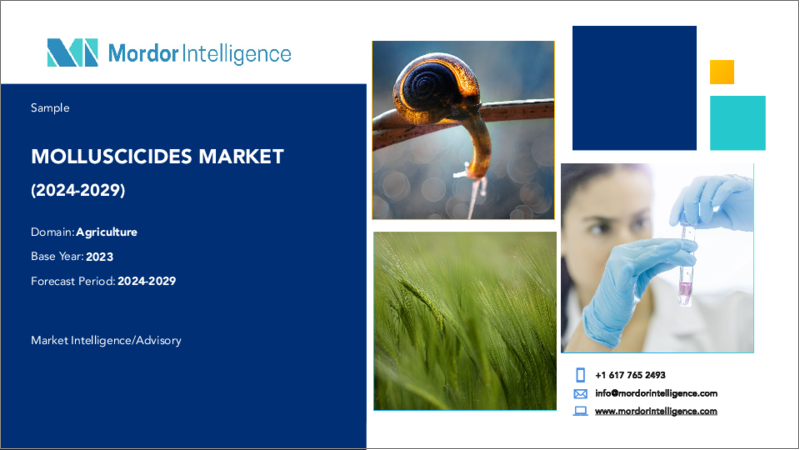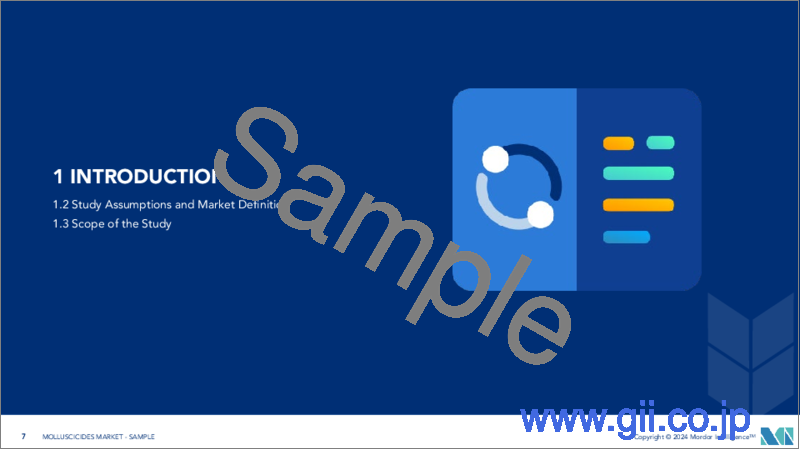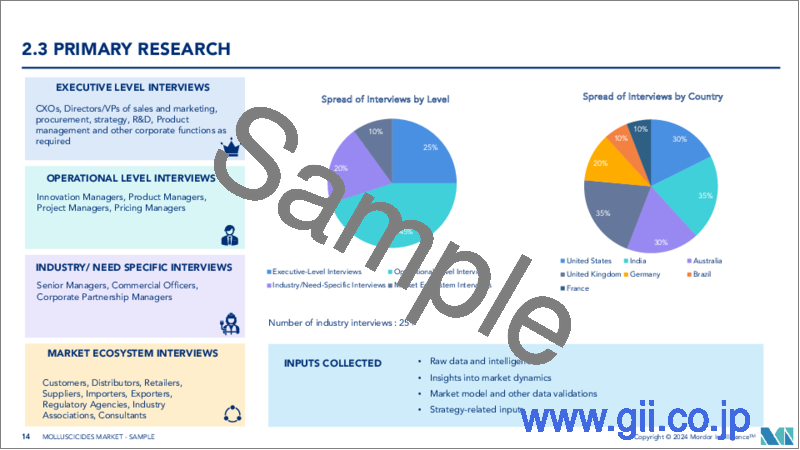|
|
市場調査レポート
商品コード
1197657
軟体動物駆除剤市場- 成長、動向、予測(2023年~2028年)Molluscicide Market - Growth, Trends, and Forecasts (2023 - 2028) |
||||||
|
● お客様のご希望に応じて、既存データの加工や未掲載情報(例:国別セグメント)の追加などの対応が可能です。 詳細はお問い合わせください。 |
|||||||
| 軟体動物駆除剤市場- 成長、動向、予測(2023年~2028年) |
|
出版日: 2023年01月23日
発行: Mordor Intelligence
ページ情報: 英文 132 Pages
納期: 2~3営業日
|
- 全表示
- 概要
- 目次
軟体動物駆除剤市場は、予測期間である2022年から2027年にかけてCAGR5.1%で成長すると予測されています。
2020年、COVID-19のパンデミック時の度重なる閉鎖と検疫のため、軟体動物駆除剤の生産と供給が制限され、市場に影響を及ぼしました。投入資材や労働力の不足により、殺軟体動物用薬剤の生産が激減。また、度重なる操業停止や輸送・通信手段の不足により、サプライチェーンが寸断されました。全体として、COVID-19の大流行が軟体動物駆除剤市場にもたらした混乱は、サプライヤーから農場レベルまで及び、生産高の減少を招きました。軟体動物駆除剤は世界の農薬市場のごく一部ですが、主に米、トウモロコシ、小麦などの穀物でカタツムリやナメクジの蔓延が増加していることから、指数関数的な成長を続けています。軟体動物駆除剤の成長の主な要因は、作物の破壊、高い人口増加による需要の増加、食の安全性と品質に対する国内需要の増加、新しい農法の採用などです。カタツムリやナメクジを防除するための化学薬品によるアプローチとしては、メタルアルデヒド、メチオカーブ、リン酸第二鉄などがよく知られています。これらの化学薬品は農作物には有効ですが、益虫には有害です。これらの生物による農作物の生産量減少のため、軟体動物駆除剤の世界市場は上昇しています。
軟体動物駆除剤の市場動向
食糧需要の増加と耕作地の減少
世界の人口は爆発的に増加しており、毎日20万人近くが世界の食糧需要に貢献しています。2050年には92億人に達すると予測されています。この増加する人口に食糧を供給することは、世界の脅威となっています。そのため、農作物の保護は、世界の食糧需要を満たすために農家が採用する重要な戦略となっています。農作物への農薬の使用は、世界の食糧生産量を増加させるために実績のある技術です。軟体動物駆除剤に対する莫大な需要は、発展途上国から寄せられています。人々は今、作物の生産性を高めるためにあらゆる手段を講じています。国連人口部によると、最も人口が増えるのはアジア(特にインド、中国、東南アジア)で、2050年には世界人口の60%以上を占めると予測されています。この地域では、増加する人口に対応した食糧増産のために、大量の農薬が必要となることが予想されます。
アジア太平洋地域が最大市場
アジア太平洋地域は、世界最大かつ最も人口の多い大陸であり、軟体動物駆除剤市場の主要市場の一つです。この地域は、2021年の世界の軟体動物駆除剤生産において最大の市場シェアを記録しており、予測期間には6.3%のCAGRで推移すると予想されています。作物保護と収穫量の最適化に関する人々の意識が、この傾向の理由の1つと考えられます。
軟体動物駆除剤市場の競合他社分析
軟体動物駆除剤市場は、非常に断片化されています。市場には多くの世界およびリージョナルプレーヤーが存在します。上位5社はLonza、Certis、Bayer CropScience Ltd、Phillagro、およびADAMAです。これらの企業は軟体動物駆除剤で最も高い市場シェアを持っています。ロンザはデンマークのバイオサイエンス企業であるChr.Hansenと50/50の合弁会社を設立し、生きたバイオ治療薬(LBP)の開発に3年間で約9000万ユーロ(1億3660万シンガポールドル)を投資します。ADAMA社は、英国でナメクジの個体数を特異的に制御するリン酸第二鉄ベースの新しい軟体動物駆除剤(Gusto IRON)を発表しました。
その他の特典
- エクセル形式の市場予測(ME)シート
- 3ヶ月間のアナリストサポート
目次
第1章 イントロダクション
- 調査の前提条件と市場の定義
- 調査対象範囲
第2章 調査手法
第3章 エグゼクティブサマリー
第4章 市場力学
- 市場概要
- 市場促進要因
- 市場抑制要因
- ポーターのファイブフォース分析
- 供給企業の交渉力
- 買い手の交渉力
- 新規参入業者の脅威
- 代替品の脅威
- 競争企業間の敵対関係
第5章 市場セグメンテーション
- 製品名
- リン酸第二鉄
- メタルアルデヒド
- メチオカルブ
- ニクロサミド
- 用途
- 穀物・穀類
- 豆類・油糧種子
- 果実および野菜
- 農園芸作物
- その他の用途
- 地域別
- 北米
- 米国
- カナダ
- メキシコ
- その他北米地域
- 欧州
- ドイツ
- 英国
- フランス
- ロシア
- スペイン
- その他の欧州地域
- アジア太平洋地域
- 中国
- 日本
- インド
- オーストラリア
- その他アジア太平洋地域
- 南米
- ブラジル
- アルゼンチン
- その他の南米地域
- アフリカ
- 南アフリカ
- その他のアフリカ
- 北米
第6章 競合情勢
- 最も採用されている戦略
- 市場シェア分析
- 企業プロファイル
- Lonza
- Certis
- Bayer Cropscience Ltd
- Syngenta
- Corteva Agriscience
- W. Neudorff GmbH KG
- Amvac Chemical Corporation
- AgroAdvanced International Ltd
- ADAMA
- Marrone Bio Innovations
第7章 市場機会と将来動向
第8章 COVID-19が市場に与える影響
The molluscicide market is projected to register a CAGR of 5.1% during the forecast period, 2022-2027.
In 2020, due to repeated lockdowns and quarantines during the COVID-19 pandemic, there were limited production and supply of molluscicide chemicals, thereby affecting the market. Production of molluscicide chemicals got declined sharply due to the shortage of inputs and labor. The supply chain got disrupted due to repeated shutdowns and a shortage of transport and communication. Overall, the disruption caused by the COVID-19 pandemic to the molluscicide market, from the suppliers to the farm level, resulted in reduced outputs. Though molluscicide constitutes a fraction of the global pesticide market, it is growing at an exponential rate, given the increasing occurrence of snail and slug infestations, mainly in cereal crops like rice, maize, and wheat. The main factor responsible for the growth of molluscicides are the destructing of crops, increase in demand due to high population growth, growing domestic demand for food safety and quality, and adoption of new farming practices. Chemical treatments such as metaldehyde, methiocarb, and ferric phosphate are the most well-known chemical-based approaches for controlling snails and slugs. These chemicals are good for agricultural crops, but they are harmful to beneficial insects. Due to the reduction in crop output caused by these organisms, the global market for molluscicide pesticides is rising.
Molluscicides Market Trends
Increasing Food Demand and Diminishing Arable Land
The global population is increasing exponentially, and every day, nearly 200,000 people are contributing to the global food demand, which is projected to reach 9.2 billion by 2050. Supplying food to this growing population has become a global threat. Thus, crop protection is a key strategy adopted by farmers to meet the global food demand. Usage of pesticides on crops is a proven technology in order to increase global food production. Huge demand for molluscicides has been seen from developing nations. People are now adopting every measure to increase crop productivity. According to the UN Population Division, the largest population increase is projected to occur in Asia (particularly in India, China, and Southeast Asia), accounting for 60% or more of the global population by 2050. Large quantities of crop protection chemicals are expected to be required in this region in order to increase food production for the growing population.
Asia-Pacific is the Largest Market
Asia-Pacific, being the largest as well as the most populous continent, is one of the key markets for the molluscicides market. This region has registered the largest market share of global molluscicides production for the year 2021, and it is expected to register a CAGR of 6.3% in the forecast period. Awareness among people regarding crop protection and optimizing yield can be one of the reasons for this trend.
Molluscicides Market Competitor Analysis
The molluscicides market is highly fragmented. There are many global and regional players in the market. The top five companies are Lonza, Certis, Bayer CropScience Ltd, Phillagro, and ADAMA. These companies have the highest market share in molluscicides. Lonza has entered into a 50/50 joint venture with Danish bioscience company Chr. Hansen to invest about EUR 90 million (SGD 136.6 million) over three years to develop live biotherapeutic products (LBP). ADAMA introduced its new ferric phosphate-based molluscicide (Gusto IRON) for specifically controlling slug populations in the United Kingdom.
Additional Benefits:
- The market estimate (ME) sheet in Excel format
- 3 months of analyst support
TABLE OF CONTENTS
1 INTRODUCTION
- 1.1 Study Assumptions and Market Definition
- 1.2 Scope of the Study
2 RESEARCH METHODOLOGY
3 EXECUTIVE SUMMARY
4 MARKET DYNAMICS
- 4.1 Market Overview
- 4.2 Market Drivers
- 4.3 Market Restraints
- 4.4 Porter's Five Forces Analysis
- 4.4.1 Bargaining Power of Suppliers
- 4.4.2 Bargaining Power of Buyers
- 4.4.3 Threat of New Entrants
- 4.4.4 Threat of Substitute Products
- 4.4.5 Intensity of Competitive Rivalry
5 MARKET SEGMENTATION
- 5.1 Product
- 5.1.1 Ferric Phosphate
- 5.1.2 Metaldehyde
- 5.1.3 Methiocarb
- 5.1.4 Niclosamide
- 5.2 Application
- 5.2.1 Grains and Cereals
- 5.2.2 Pulse and Oil seeds
- 5.2.3 Fruits and Vegetables
- 5.2.4 Plantation Crops
- 5.2.5 Other Applications
- 5.3 Geography
- 5.3.1 North America
- 5.3.1.1 United States
- 5.3.1.2 Canada
- 5.3.1.3 Mexico
- 5.3.1.4 Rest of North America
- 5.3.2 Europe
- 5.3.2.1 Germany
- 5.3.2.2 United Kingdom
- 5.3.2.3 France
- 5.3.2.4 Russia
- 5.3.2.5 Spain
- 5.3.2.6 Rest of Europe
- 5.3.3 Asia-Pacific
- 5.3.3.1 China
- 5.3.3.2 Japan
- 5.3.3.3 India
- 5.3.3.4 Australia
- 5.3.3.5 Rest of Asia-Pacific
- 5.3.4 South America
- 5.3.4.1 Brazil
- 5.3.4.2 Argentina
- 5.3.4.3 Rest of South America
- 5.3.5 Africa
- 5.3.5.1 South Africa
- 5.3.5.2 Rest of Africa
- 5.3.1 North America
6 COMPETITIVE LANDSCAPE
- 6.1 Most Adopted Strategies
- 6.2 Market Share Analysis
- 6.3 Company Profiles
- 6.3.1 Lonza
- 6.3.2 Certis
- 6.3.3 Bayer Cropscience Ltd
- 6.3.4 Syngenta
- 6.3.5 Corteva Agriscience
- 6.3.6 W. Neudorff GmbH KG
- 6.3.7 Amvac Chemical Corporation
- 6.3.8 AgroAdvanced International Ltd
- 6.3.9 ADAMA
- 6.3.10 Marrone Bio Innovations




